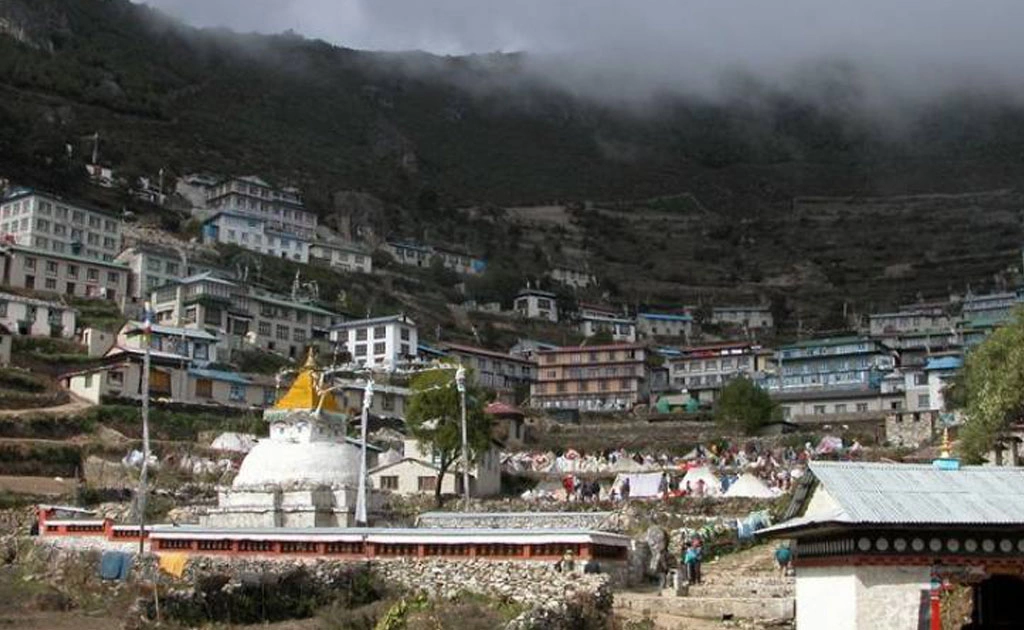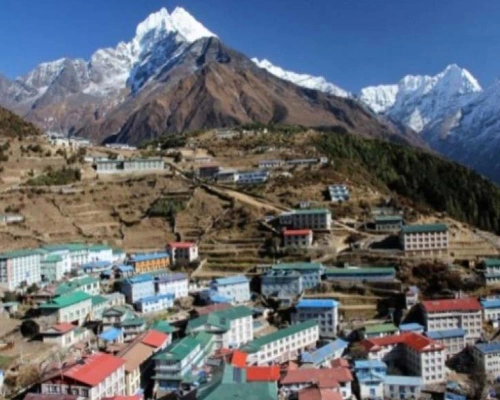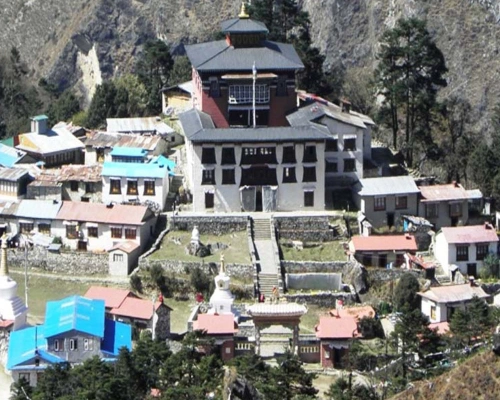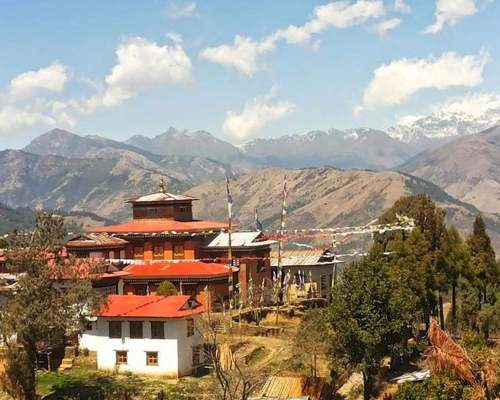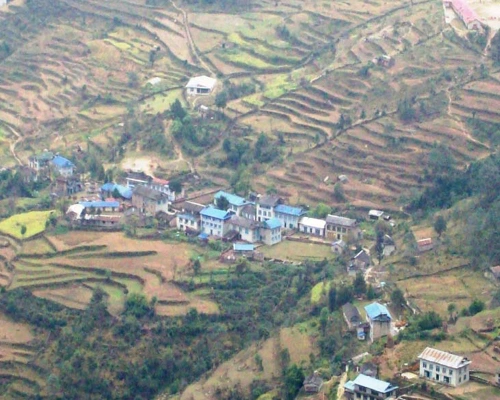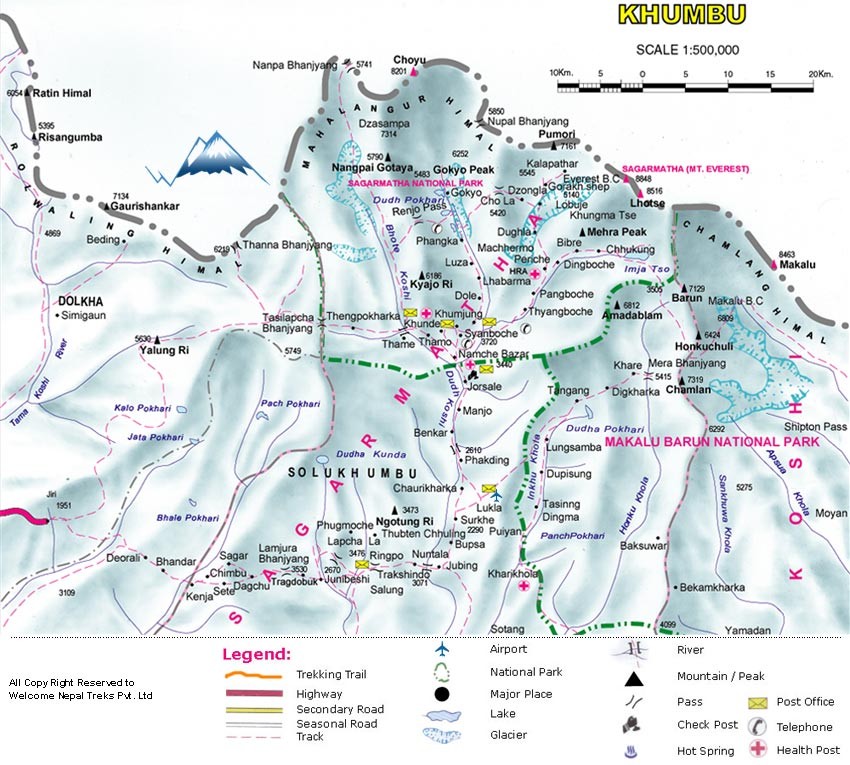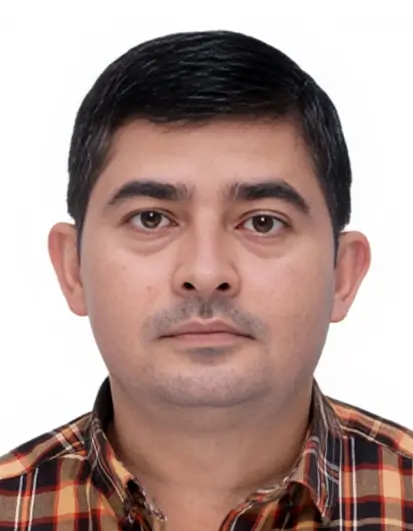Best seasons to do 9 days Sherpa Village Trek
For trekking in any regions, the weather plays a significant and vital role. Apart from any seasons throughout the year, you can travel in spring and autumn seasons. These two season are best to travel any destination. The weather is warm, moderate, and stable. The average temperature on these seasons ranges from 10 to 15 degrees.
In this spring season, you will get chance to see the different types of rhododendron and wilder flower. While in autumn, you get the most beautiful views of mountains and valleys. There are no heavy rain and snowfall.
Packing tools for 9 days Sherpa Village Trek
- A few pairs of Thermal tops
- Fleece jacket/pullover
- Windcheater - waterproof shell jacket one pair
- Down jacket
- Comfortable Fleece/wool trousers
- Trekking pants- at least 2 pairs
- Mittens/woolen gloves
- Warm Hiking socks
- Hiking Cotton trousers/t-shirts
- Sun hat/scarf, wash towel
- Sunglasses
- Sleeping bag
- Trekking poles
- Day bag above 40 L
- Basic personal first aid kit
- Water bottles, water purification tablets
Accommodations during 9 days Sherpa Village Trek
Tea houses are the most common form of accommodations. These are small guesthouses run by local Sherpa’s families. Tea houses provide basic facilities such as private or shared rooms with beds, blankets and pillow. They also have communal dining areas where you can enjoy meals. While the facilities are simple, tea houses offer a cozy and authentic experience. In some villages, you may have the opportunity to stay in Sherpa homestay. Accommodations in homestays are typically basic, with shared facilities and traditional meals prepared by the host family.
Foods during 9 days Sherpa Village Trek
During treks in Sherpa village you can expect to find a variety of traditional Sherpa foods along with other Nepali and Tibetan influences. Tea houses especially offers dal bhat, it is the staple dish of Nepal and consists of lentil soup (dal) served with steamed rice (bhat). It’s often accompanied by vegetables, pickles and sometimes meat or curry. They also serve momos (steamed or fried dumplings filled with vegetables or meat), thukpa (noodles soup), ghundruk (fermented leafy greens), fried rice, chapatti (flat bread) in some tea houses. Many tea houses along the route also serve international dishes such as pasta, noodles, fried rice, pancakes and soups.
Drinking water during 9 days Sherpa Village Trek
Drinking water is important because it keeps you hydrated. The safe drinking water is available in the teahouses and hotels during 9 days Sherpa village trek. You can buy the bottled water, filter water or hot water. It is advisable that bring the water bottles and water purification tablets by yourself then it will be plus point for you. You don’t have to buy the mineral water daily, you can fill the water in the tap and purify by yourselves that will help you to save money.
Wi-Fi electricity and hot shower availability in 9 days Sherpa Village Trek
The availability of Wi-Fi, electricity and hot water for showers can vary depending on the specific location along the trail. In most of the tea houses along the trekking route, Wi-Fi is available but you have to pay additional fee. However please note that the quality and reliability of the internet connection can vary. In more remote and higher altitude areas, the Wi-Fi signal may be weak or nonexistent. Electricity will be limited because it is generated through solar panels. Charging electronic devices like cameras, phones or batteries may incur an additional fees. Hot shower facilities are available in most of the tea houses along the trekking routes. However, it’s important to note that hot showers are often not included in the standard room rate and may require an additional fee.
9 days Sherpa Village Trek Difficulty
The difficulty level of 9 days Sherpa village trek can vary depending on the specific route and duration of the trek. However treks in the Everest region that pass through Sherpa villages generally fall under the category of moderate to strenuous. The primary factor contributing to the difficulty is the high altitude of the region. The terrain in the Everest region can be challenging. The trails often involve steep ascent and descent, rocky paths and occasional exposure to heights. Some part if the trek may require crossing suspension bridges and navigating uneven terrain. Trekking days can be long, ranging from 6- hours of walking per day. Physical fitness is important for tackling the trek comfortably. Regular exercise and cardiovascular training before the trek can help prepare your body for the demands of the journey.
Guides and porters for 9 days Sherpa Village Trek
While it is not mandatory to have guides and porters for 9 days Sherpa village trek but many trekkers choose to hire guides and porters to enhance their trekking experience and make their journey more comfortable. Sherpa guides, who are often locals from the region, possess extensive knowledge about the trekking routes, weather conditions, altitude and local culture. They can provide valuable guidance, ensure your safety and assist you in navigating through challenging terrains. Having a guide ensures that you stay on the right path, especially in case of challenging sections or changing weather conditions. Guides often serves as a translator between trekkers and the local community, helping facilitate communications and interactions. As well as, hiring a porters can alleviate the physical burden of carrying heavy backpacks, allowing you to enjoy the trek more comfortably.
Permits during 9 days Sherpa Village Trek
When embarking on a 9 days Sherpa village trek in Nepal, you may need to obtain certain permits depending on the specific route and destination you plan to visit. Here are the permits required for 9 days Sherpa village trek are Sagarmatha national park entry permit and ), TIMS (Trekkers Information Management System) card. It is all provided by welcome Nepal treks and also it is included on our tour package.
Travel insurance for 9 days Sherpa Village Trek
Obtaining travel insurance is highly recommended for any trekking adventure, including 9 days Sherpa village trek. Ensure that your travel insurance policy provides comprehensive medical coverage, including emergency medical evacuation and repatriation. Trekking at high altitude involves risks, and its crucial to have coverage for any potential altitude sickness or medical emergencies that may arise during the trek.
Tipping for 9 days Sherpa Village Trek
Tipping is a common practice in the tourism industry, including for trekking guides, porters, and other support staff. While tipping is not mandatory, it is appreciated and considered a way to show gratitude for the service provided. It’s important to note that these are general guidelines, and tipping is ultimately personal decisions. You may choose to adjust the amount based on your satisfaction with the service and your budget.
Why to do 9 days Sherpa Village Trek?
The Sherpa villages are nestled in the stunning landscapes of the Himalayas with towering snow- capped peaks, lush green valleys and cascading waterfalls. The 9 days Sherpa village trek takes you through picture square trails that offer breathtaking panoramic views at every turn. The beauty of the natural surroundings is awe-inspiring and provides an incredible backdrop for your journey. The Sherpa people have a rich cultural heritage that is deeply intertwined with the mountains. By trekking through their villages, you have the opportunity to immerse yourself in their way of life, interact with the locals, and learn about their traditions, religion (predominantly Buddhism) and daily routines. It’s a chance to gain insight into a fascinating culture that has a deep connection to the mountains. The Sherpa villages are often located in remote areas, away from the hustle and bustle of modern life. This provides a chance to escape the noise and pollution of urban environments and immerse yourself in tranquility of nature.
Why to do 9 days Sherpa Village Trek with Welcome Nepal Treks?
Welcome Nepal treks have been operating for many years and has extensive experience in organizing treks in Nepal. Welcome Nepal Treks offers a splendid trek package to the customers at a very reasonable price with great services. We have knowledgeable and experienced guides who are familiar with the trekking routes, safety protocols, and local customs. Their expertise can enhance your trekking experience and ensure a smooth journey. We offers flexible and customizable itineraries to cater to individual preferences and requirements. We can tailor the trek to suit your time frame, fitness level and specific interested. Welcome Nepal treks takes care of the logistical aspects of the trek, including permits, accommodations, transportation, and meals.
Risks during Sherpa Village Trek
Trekking through the Sherpa villages in the Khumbu region of Nepal, or any trek in the Himalayas comes with certain risks and challenges that trekkers should be aware of and prepared for. Some of the common risks during a Sherpa Village Trek include:
- Altitude sickness
- Harsh weather conditions
- Physical exhaustion
- Challenging trail conditions
- Food and water safety
- Remote location
- Wildlife encounters
- Avalanches and landslides
- Respecting local culture
- Trekking permits and regulations
Preventing Altitude Sickness (AMS) during the Sherpa Village Trek
Preventing altitude sickness (AMS) during a Sherpa Village Trek or any high-altitude trek is crucial for your safety and enjoyment. Here are some key steps to minimize the risk of AMS:
- Gradual ascent and acclimatization
- Stay hydrated
- Avoid alcohol and tobacco
- Balanced diet and sufficient calories
- Recognize AMS symptoms
- Medication (consult a healthcare professional)
- Sleep at lower elevations
- Moderate pace, avoid overexertion
- Deep, slow breathing
- Consider local remedies
- Travel with an experienced guide
Training for Sherpa Village Trek
Training for the Sherpa Village Trek involves a mix of cardiovascular fitness, strength training, and endurance. Prioritize activities like hiking, walking, and jogging to build your cardiovascular stamina. Strengthen your legs, core, and upper body with weight training and bodyweight exercises to cope with the demanding terrain. Practice walking with a loaded backpack to simulate trek conditions and break in your trekking gear.
Distance and Time during Sherpa Village Trek
The total distance and time for the entire Sherpa Village Trek can vary depending on the specific route and side trips you choose to take. The complete Sherpa Village Trek, from Lukla and back, can cover approximately 70 to 90 miles (110 to 145 kilometers) in total, depending on the exact route and optional side trips. The total trek duration can range from 8 to 12 days, allowing for acclimatization, rest days, and exploration of Sherpa villages, monasteries, and cultural sites along the way. Each day of trekking typically involves 4 to 7 hours of walking, depending on the specific leg of the journey and your pace.
Can I book Private Sherpa Village Trek?
If you want to enjoy your tour alone then you can book Sherpa Village Trek. Welcome Nepal Treks offer customizable tour packages, including private tours, to cater to individual preferences and needs. You can discuss your preferences and requirements with us and we will design a tour that suits your specific interests and travel style. With a private tour, you can enjoy personalized services, flexibility in scheduling, and the opportunity to explore the destinations at your own pace.
Can I join the Group on Sherpa Village Trek?
Yes, Welcome Nepal Treks offers group joining Sherpa Village Trek. Welcome Nepal treks organize the group joining on the fixed departure date. Joining a group can provide a cost-sharing benefits. Not only that, you have opportunity of meeting new people from different nation and a chance of learning their culture. In comparison of trekking alone, trekking with groups can be more enjoyable and fun.
What is the Cost of the 9 days Sherpa Village Trek?
The cost of 9 days Sherpa Village Trek can vary based on several factors including the type of trek (private or group), the level of services and accommodation, and the season of tour you choose. According to the service, provided by us (Welcome Nepal Treks), we offer the Sherpa Village Trek at a very reasonable price. We offer this splendid 9 days Sherpa Village Trek package around US$800 - $1000 with the quality services. The cost includes the permits, meals, guides and everything mentioned in the package.
Why Sherpa Village Trek with Us?
Welcome Nepal treks have been operating for many years and has extensive experience in organizing treks in Nepal. Welcome Nepal Treks offers a splendid trek package to the customers at a very reasonable price with great services. We have knowledgeable and experienced guides who are familiar with the trekking routes, safety protocols, and local customs. Their expertise can enhance your trekking experience and ensure a smooth journey. We offers flexible and customizable itineraries to cater to individual preferences and requirements. We can tailor the trek to suit your time frame, fitness level and specific interested. Welcome Nepal treks takes care of the logistical aspects of the trek, including permits, accommodations, transportation, and meals. Also, we highly care for the safety of our customers and make them satisfied with our services. From picking up in airport, lodging, transportation to dropping at the airport for departure; everything will be done in professional ways
Sherpa Village Trek Booking and Payment Policies
If you want to book the Sherpa Village Trek with Welcome Nepal Treks then, we need the photocopy of your passport and you have to pay us a minimum of 10% payment of the total cost as advance. You can pay us through different medium like cash, bank transfer, or online. We accept booking deposits through Credit Cards (Master Card or Visa and many more). You can also pay us direct cash. We also accept your last minute booking but the booking should be done at least before one day prior to the trip departure date. If you have any question regarding the trek, then feel free to contact us.
Trip extension after Sherpa Village Trek
If you want to extend your trip after completing the Sherpa Village Trek, there are several options available to explore more of Nepal's natural beauty. Some of the few popular trip extension are mentioned below:
- Annapurna Base Camp Trek
- Ghorepani-Poon Hill Trek
- Chitwan National Park with Tower Night Stay
- Bardia National Park Safari
- Rara Lake Trek
- Manaslu Circuit Trek
- Tansen and Palpa
- Lumbini and Buddhist Circuit
- Pokhara Adventure Activities
- Kalinchowk Temple Trek
- Gosainkunda Trek
- River Rafting
- UNESCO World Heritage Sites like Kathmandu Durbar Square, Swayambhunath, Boudhanath, and Pashupatinath.
ATM and money exchange service during Sherpa Village Trek
ATM and money exchange services are limited during the Sherpa Village Trek due to its remote location. While you may find ATMs in larger villages like Namche Bazaar and Lukla, they can be unreliable and have transaction limits. It's advisable to carry sufficient Nepalese rupees in cash for expenses during the trek, as money exchange services are available but may offer less favorable rates than in urban areas like Kathmandu.
